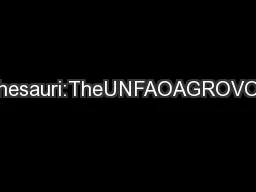PDF-twowidelyusedagriculturalthesauri:TheUNFAOAGROVOCThesaurus(28,169conce
Author : tatyana-admore | Published Date : 2015-12-07
4httpwwwificorghttpwwwcfsanfdagov152dmsfoodichtml5httpwwwgooglecom patternfreq part inftheg whole 488 part forfuseinjmakingg whole 129 part fortied whole 74 part from whole
Presentation Embed Code
Download Presentation
Download Presentation The PPT/PDF document "twowidelyusedagriculturalthesauri:TheUNF..." is the property of its rightful owner. Permission is granted to download and print the materials on this website for personal, non-commercial use only, and to display it on your personal computer provided you do not modify the materials and that you retain all copyright notices contained in the materials. By downloading content from our website, you accept the terms of this agreement.
twowidelyusedagriculturalthesauri:TheUNFAOAGROVOCThesaurus(28,169conce: Transcript
Download Rules Of Document
"twowidelyusedagriculturalthesauri:TheUNFAOAGROVOCThesaurus(28,169conce"The content belongs to its owner. You may download and print it for personal use, without modification, and keep all copyright notices. By downloading, you agree to these terms.
Related Documents

